The State Herbarium of South Australia wishes all followers of the blog, its volunteers, staff, Hon. Research Associates and Research Affiliates a relaxing Christmas break and all the best for the New Year 2022.
Taming the heaths: re-definition of Styphelia and Leucopogon and the demise of Astroloma
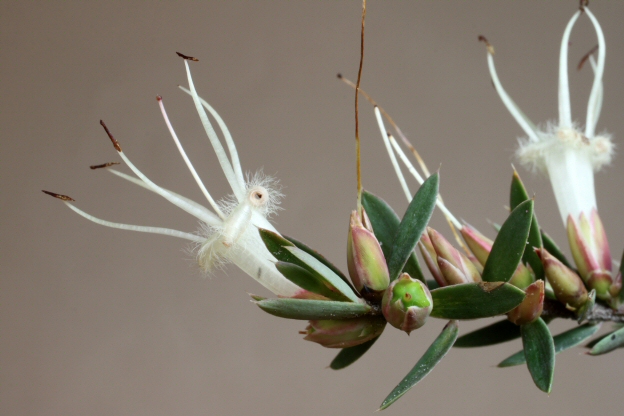
Styphelia adscendens, Nangwarry, SE. Photo: P.J.Lang
Results of molecular phylogenetic studies (Crayn, Hislop & Puente-Lelièvre 2020) have recently been applied to the SA Plant Census, affecting six native species of heath in this State. Five of the South Australian Leucopogon species, along with Astroloma humifusum, have been transferred to an expanded Styphelia. As a result, Astroloma has effectively been dismembered; the only other SA species, A. conostephioides (Flame Heath) was recently transferred to Stenanthera conostephioides.
The Australian or southern heaths have traditionally been placed in their own family, Epacridaceae. However, the most recent treatments now incorporate them as a subfamily, Epacridoideae, within the globally widespread family Ericaceae, which includes well known plants such as Heather (Calluna) in Europe and Erica in South Africa. The phylogeny of the largest tribe of the subfamily, Stypheliae, was studied by Puente-Lelièvre et al. (2015), using both nuclear and chloroplast DNA and showed that Styphelia, Leucopogon, Astroloma and other genera represented in the largest clade were not monophyletic as currently defined.
Faced with the choice of recognising a single large genus, or at least 12 smaller genera, the authors opted for the former and expanded the circumscription of Styphelia to include all of the taxa falling within the Styphelia-Astroloma clade. While the redefined Styphelia is less informative about the morphological diversity present in the clade, it involved fewer name changes, and priority was given to maximising nomenclatural stability.
Styphelia has been defined in various ways in its long and chequered history. It is noteworthy that none of the ‘new’ names for South Australia are actually new combinations – all had been treated as species of Styphelia at some time in the past by various authors. This can be seen in the listing of synonyms under Leucopogon and Astroloma in the Census. It demonstrates past difficulties of defining the genus in a robust way based on morphology alone, when weighting different characters gives different outcomes and the derivation of character states and homologies are not obvious.
As most recently understood, Styphelia was only represented by two species in SA, S. adscendens and S. exarrhena, characterised by their much-exserted stamens (see first two figures). However, in the phylogenies from the recent molecular studies a number of Leucopogon species cluster together with these, and the circumscription of the newly defined genus is now expanded by the addition of other species with shorter stamens, as shown in the following images.
The two pre-existing SA Styphelia species, showing exserted stamens: Styphelia adscendens (image above) and S. exarrhena (below).

Styphelia exarrhena, Cox Scrub CP, SL (BSOP-520). Photo: P.J.Lang.
The five new species of Styphelia, which were transferred from Leucopogon: Styphelia clelandii, S. cordifolia, S. ericoides, S. rufa and S. woodsii.
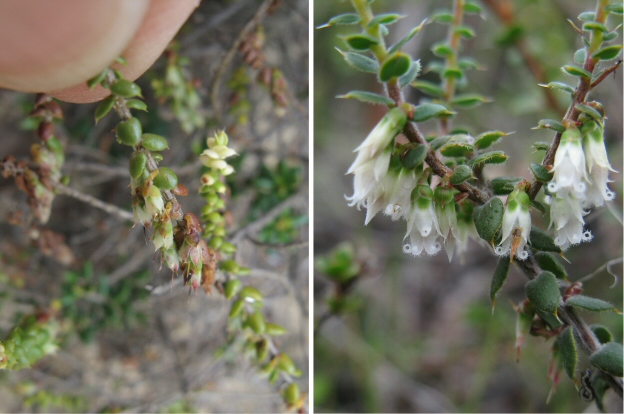
Styphelia clelandii (formerly Leucopogon clelandii): (LHS) Hardy Reserve, SE. Photo: A. Carle. (RHS) Ngarkat CP, SE. Photo: G. Carle.
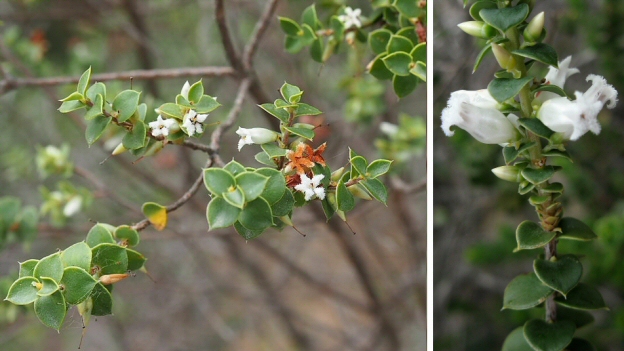
Styphelia cordifolia (formerly Leucopogon cordifolius): (LHS) Talbot Reserve, MU. Photo: SA Seed Centre. (RHS) Scorpion Springs Track, SE. Photo: G. Carle.

Styphelia ericoides (formerly Leucopogon ericoides): (LHS) Penola CP, SE (DEM 7622). Photo: D.E. Murfet. (RHS) near Bangham Siding Rd, SE (PJL 2789). Photo: P.J. Lang.
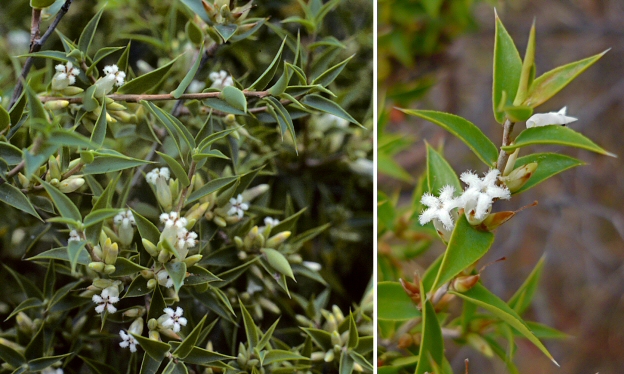
Styphelia rufa (formerly Leucopogon rufus): (LHS) Port Willunga, SL (DNK 622). Photo: D.N. Kraehenbuehl. (RHS) Aldinga Scrub CP, SL. Photo: J. Burgher.

Styphelia woodsii (formerly Leucopogon woodsii), Bullock Hill CP, SL. Photo: D.E. Murfet, (LHS) DEM 2630, (RHS) DEM 2700.
The former Astroloma humifusum, now Styphelia humifusa:
That this plant appears so different to the others can be related to its long floral tube and red colouration being adaptions for pollination by birds rather than insects.
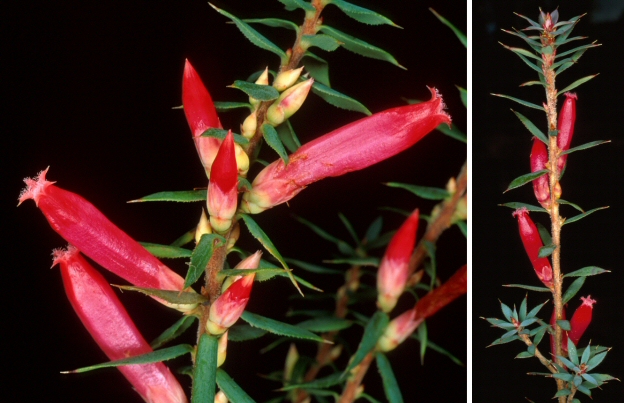
Styphelia humifusa (formerly Astroloma humifusum), The Bluff Range NFR, NL (BSOP-522). Photo: P.J. Lang.
Prepared by State Herbarium botanist Peter Lang.
Bush Blitz 2021 (1)
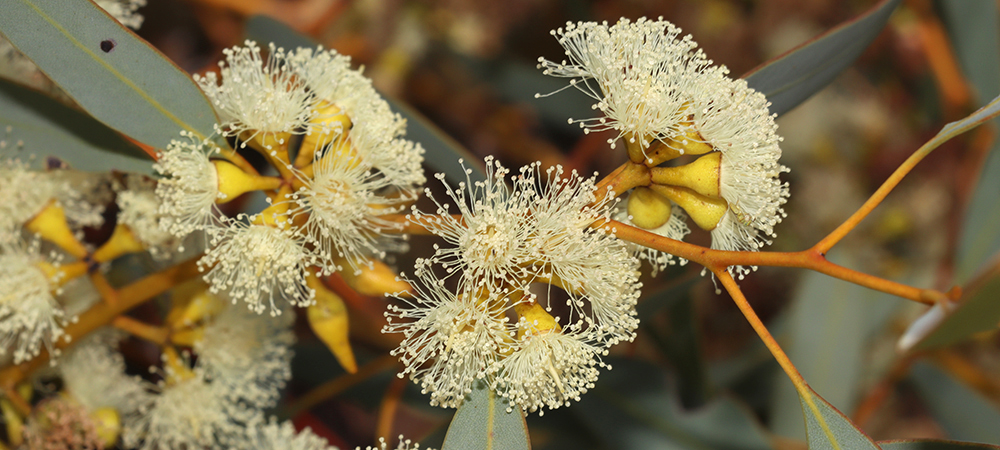
Flowers of Eucalyptus yalatensis, a species growing on calcareous soils, which was first described from specimens from the Yalata area. Photo: T. Hammer.
A team of four botanists from the State Herbarium of South Australia just returned from the Bush Blitz Expedition to Yalata Indigenous Protected Area (IPA), Wahgunyah & Fowlers Bay Conservation Parks in the Far West of the State. For two weeks, from 22 Nov. to 3 Dec. 2021, Peter Lang, Tim Hammer, Jürgen Kellermann and Tracey Spokes explored the area, surveyed the vegetation and collected new specimens for the State Herbarium collection.
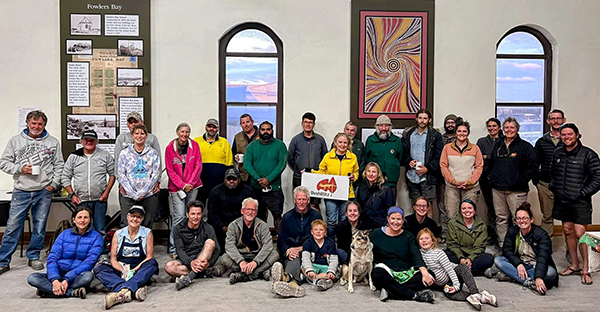
Some of the Bush Blitz participants, including State Herbarium botanists, with the local support team and Aboriginal Rangers on the last day before leaving Fowlers Bay. Photo: Bush Blitz (Facebook).
We are extremely grateful to the Far West Coast people, including the Kokatha, Mirning, Wirangu, Yalata, and Maralinga Tjarutja (Oak Valley) Peoples and the descendants of Edward Roberts, the Traditional Owners of the land, for allowing us access and permitting us to collect plants.

Limestone cliff vegetation at the Nullarbor, near Head of Bight, Yalata IPA, surveyed by the State Herbarium team during the Bush Blitz expedition. Photo: T. Hammer.
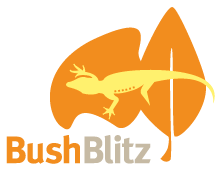 Bush Blitz is an innovative partnership between the Australian Government, BHP Billiton Sustainable Communities and Earthwatch Australia. It is the world’s first continent-scale biodiversity survey, providing the knowledge needed to help us protect Australia’s unique animals and plants for generations to come.
Bush Blitz is an innovative partnership between the Australian Government, BHP Billiton Sustainable Communities and Earthwatch Australia. It is the world’s first continent-scale biodiversity survey, providing the knowledge needed to help us protect Australia’s unique animals and plants for generations to come.
New journal articles: Nov. 2021

Eucalyptus dissimulata subsp. plauta, a new taxon from WA, described by Nicolle & French. Photo: D. Nicolle.
The State Herbarium of South Australia published two articles in Vol. 35 of its journal Swainsona online, today, 18 Nov. 2021.
(1) D. Nicolle & M.E. French. A taxonomic revision of the semi-cryptic narrow-leaved mallees (Eucalyptus series Porantherae, Myrtaceae) from southern Australia. (61mb PDF).
In this large 80-page-monograph, based on extensive observations in the field and herbarium over the last 30 years, the authors revise the semi-cryptic ‘narrow-leaved mallees’, Eucalyptus ser. Porantherae, from southern Australia. They recognise a total of 23 species and 6 subspecies, many of which are described in this paper for the first time. For all taxa in the series, updated descriptions and distributions are provided (including distribution maps), as well as an identification key to the series.
(2) M. Wapstra. Hibbertia mathinnicola (Dilleniaceae), a new endemic species from northeastern Tasmania. (1.6mb PDF).
The author describes and illustrates a new endemic species of Hibbertia that is highly localised to northeastern Tasmania. Plants of this species have previously been identified as Hibbertia calycina (DC.) N.A.Wakef., but this species now considered to be restricted to mainland Australia.
To access content of all volumes of Swainsona and the Journal of the Adelaide Botanic Gardens since Vol. 1 (1976), please visit the journal’s web-site at flora.sa.gov.au/swainsona or the Swainsona back-up site.
New journal article: October 2021
The State Herbarium of South Australia published one lichenological paper in Vol. 35 of its journal Swainsona online, today, 29 Oct. 2021.
G. Kantvilas & A.M. Fryday, Validation of Henry Imshaug’s “Ochrolechia alectoronica” (lichenised Ascomycetes, Pertusariales), with notes on O. weymouthii Jatta and a key to the genus Ochrolechia in Tasmania. (2mb PDF).
The authors discuss two species of Ochrolechia and provide a key to all Tasmanian species. One new species is described, Ochrolechia alectoronica, using a manuscript name by Imshaug, that he used on many specimens from two islands in New Zealand’s Southern Ocean: the Auckland and Campbell islands. The species is also found in Tasmania, as is the closely related O. weymouthii, which occurs in Tasmania and Victoria.
More information about Henry Imshaug’s collections, the main set of which is held at the Michigan State University Herbarium (MSU), can be found in an article by Fryday & Prather (130kb PDF).

Ochrolechia alectoronica, a new lichen species from Tasmania and New Zealand’s Campbell & Auckland islands. Photo: J. Jarman.
To access content of all volumes of Swainsona and the Journal of the Adelaide Botanic Gardens since Vol. 1 (1976), please visit the journal’s web-site at flora.sa.gov.au/swainsona or the Swainsona back-up site.



You must be logged in to post a comment.